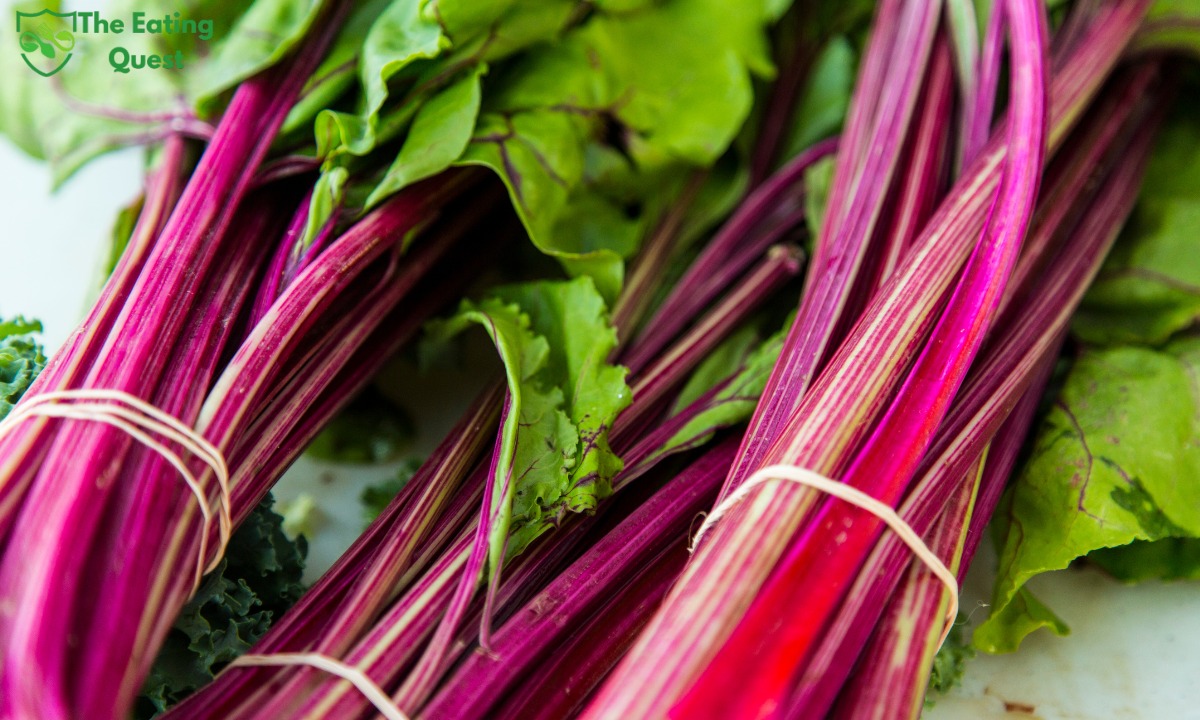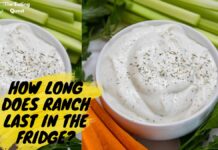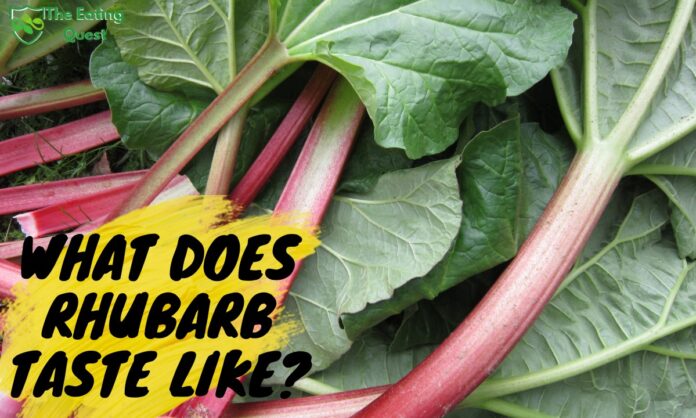If you’ve never tasted rhubarb before, you may be wondering what it tastes like. Rhubarb is a vegetable that is often used in sweet dishes, and it has a unique flavor that is difficult to describe. Some people describe the taste as tart, while others say it is sour or slightly bitter.
The flavor of rhubarb can vary depending on how it is prepared. When cooked, rhubarb has a softer texture and a sweeter taste. Raw rhubarb, on the other hand, is much more tart and crunchy. Many people enjoy the contrast between the tartness of raw rhubarb and the sweetness of sugar or other sweeteners.
Overall, rhubarb has a distinct taste that is hard to compare to any other vegetable or fruit. If you’re looking to try rhubarb for the first time, it’s best to start with a recipe that includes sugar or another sweetener to balance out the tartness. From there, you can experiment with different preparations to discover your favorite way to enjoy this unique vegetable.
What is Rhubarb?
Rhubarb is a vegetable that is often used in desserts and baked goods. It has a long, thick stalk that is similar in appearance to celery, but with a reddish-pink hue. The leaves of the rhubarb plant are large and green, and are not edible due to their high levels of oxalic acid, which can be toxic to humans.
Rhubarb is often referred to as the “pie plant” because it is commonly used as a filling for pies, tarts, and other desserts. It has a tart, slightly sour taste that is often paired with sweet ingredients to balance out the flavor.
Rhubarb is a seasonal vegetable that is typically harvested in the spring and early summer months. It can be found in grocery stores and farmers’ markets during this time, but may be more difficult to find at other times of the year.
When selecting rhubarb, look for stalks that are firm and brightly colored. Avoid stalks that are wilted, limp, or discolored. Rhubarb can be stored in the refrigerator for up to a week, but should be used as soon as possible for the best flavor.
Overall, rhubarb is a unique and flavorful vegetable that can add a tart and refreshing taste to a variety of dishes.
What Does Rhubarb Taste Like?
If you’ve never tried rhubarb before, you might be wondering what it tastes like. Rhubarb is a unique vegetable that is often used in desserts and jams. It has a distinct flavor that is both sweet and tart, with a slightly sour aftertaste.
Sweetness
Rhubarb is not as sweet as many fruits, but it does have a natural sweetness that is balanced by its tartness. The sweetness of rhubarb varies depending on the variety and how it is prepared. Generally, the redder the stalks, the sweeter they will be. When cooked with sugar, the sweetness is enhanced and the tartness is mellowed out.
Tartness
The tartness of rhubarb is what gives it its distinctive flavor. It is often described as sour or tangy, but it is not overpowering. The tartness of rhubarb is balanced by its sweetness, making it a great ingredient for desserts and jams. Some people enjoy the tartness of rhubarb on its own, but others prefer it cooked with sugar to mellow out the flavor.
Texture
The texture of rhubarb is also unique. The stalks are firm and crisp, but they soften when cooked. The texture of cooked rhubarb is often described as mushy, but it can also be slightly stringy. When used in desserts, the texture of rhubarb is often balanced by other ingredients like crusts or toppings.
In summary, rhubarb has a distinct sweet and tart flavor with a slightly sour aftertaste. The sweetness and tartness are balanced, and the texture is firm when raw and mushy when cooked.
Factors Influencing Rhubarb Taste
Cultivation
The taste of rhubarb can vary depending on the way it is cultivated. The following factors can influence the taste of rhubarb:
- Variety: Different varieties of rhubarb have different flavors. Some varieties are sweeter, while others are more tart. Victoria and Cherry Red are two of the most popular varieties of rhubarb.
- Soil: The soil in which rhubarb is grown can affect its taste. Rhubarb grows best in well-drained soil that is rich in organic matter. Soil with a pH of 6.0-6.8 is ideal for rhubarb cultivation.
- Climate: Rhubarb grows best in cool, temperate climates. Warm temperatures can cause rhubarb to become tough and woody, while cold temperatures can make it more tender and flavorful.
Preparation Methods
The way in which rhubarb is prepared can also affect its taste. Here are some factors to consider:
- Cooking Method: The most common way to prepare rhubarb is by cooking it. The cooking method can affect the taste and texture of the rhubarb. Boiling rhubarb can make it mushy, while baking it can help it retain its shape and texture.
- Sweeteners: Rhubarb is naturally tart and often requires sweeteners to balance out its flavor. Sugar is the most common sweetener used with rhubarb, but honey, maple syrup, and agave nectar can also be used.
- Spices: Spices can be used to enhance the flavor of rhubarb. Cinnamon, nutmeg, and ginger are popular spices that pair well with rhubarb.
In summary, the taste of rhubarb can be influenced by a variety of factors, including its cultivation and preparation methods. By taking these factors into consideration, you can ensure that your rhubarb dishes are flavorful and delicious.

Comparing Rhubarb to Other Foods
Rhubarb vs Berries
When it comes to taste, rhubarb has a unique flavor that can be difficult to compare to other fruits. However, it is often compared to berries due to their similar tartness and sweetness. While rhubarb has a distinct sour taste, it can also be quite sweet, especially when combined with sugar.
In terms of texture, rhubarb is more fibrous than most berries, which can be either a positive or negative depending on personal preference. Rhubarb is also less juicy than most berries, which can make it less refreshing on a hot day.
Overall, rhubarb can be a great addition to berry-based desserts, adding a unique flavor and texture to the dish.
Rhubarb vs Citrus Fruits
Rhubarb is often compared to citrus fruits due to their shared tartness. However, rhubarb has a more complex flavor profile than most citrus fruits, with hints of sweetness and bitterness.
In terms of texture, rhubarb is much less juicy than most citrus fruits, which can make it less refreshing. However, it is also less acidic, which can make it more palatable for some people.
When it comes to cooking, rhubarb can be used in many of the same ways as citrus fruits, such as in pies, tarts, and jams. However, rhubarb can also be used in savory dishes, such as in sauces for meats.
Overall, rhubarb and citrus fruits have some similarities in terms of tartness, but rhubarb has a more complex flavor profile and can be used in a wider variety of dishes.
Conclusion
In conclusion, rhubarb is a unique vegetable with a distinct taste that can be described as tart, sour, and slightly sweet. It is often used in desserts and baked goods, but can also be used in savory dishes.
When cooked, rhubarb softens and its tartness is balanced by the addition of sugar. It can also be eaten raw, but the taste may be too sour for some people.
While rhubarb is a good source of vitamins and minerals, it should be consumed in moderation due to its high levels of oxalic acid.
Overall, if you enjoy tart and sour flavors, you may enjoy the taste of rhubarb. It is a versatile ingredient that can be used in a variety of dishes, and is worth trying if you have not already.
Frequently Asked Questions
What are some popular rhubarb recipes?
Rhubarb is a versatile ingredient that can be used in both sweet and savory dishes. Some popular rhubarb recipes include rhubarb pie, rhubarb crisp, rhubarb jam, rhubarb chutney, rhubarb sauce, and rhubarb compote. You can also use rhubarb in cakes, muffins, and bread.
What are some flavor pairings for rhubarb?
Rhubarb has a tart flavor that pairs well with sweet flavors. Some popular flavor pairings for rhubarb include strawberries, raspberries, blueberries, apples, oranges, ginger, and vanilla.
What are the health benefits of eating rhubarb?
Rhubarb is a good source of fiber, vitamin K, potassium, and calcium. It has been shown to have anti-inflammatory properties and may help lower cholesterol levels. However, it is important to note that rhubarb leaves are toxic and should not be eaten.
Is rhubarb poisonous and how should it be prepared?
While rhubarb stalks are safe to eat, the leaves are toxic and should be discarded. Rhubarb should be washed and trimmed before use. It can be cooked in a variety of ways, including boiling, baking, and stewing.
How do you cook rhubarb on the stove and for how long?
To cook rhubarb on the stove, chop the rhubarb stalks into small pieces and place them in a saucepan with a little water and sugar. Cook over medium heat for 10-15 minutes, stirring occasionally, until the rhubarb is soft and tender.
Why do people eat rhubarb and how would you describe its taste?
Rhubarb is a popular ingredient in desserts because of its tart flavor and bright red color. Some people also enjoy it in savory dishes like stews and chutneys. The taste of rhubarb can be described as tart, slightly sour, and refreshing.
Also Read:
















